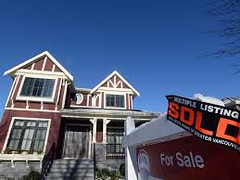Real estate market may cause great damages to the economy if risks occur
Real estate is currently the channel that attracts the most capital. The information that the government is working on housing credit support programme along with the recently adopted bad debt settlement resolution have made the market to be more exciting.

The housing credit support package is just being studied now. As per experts, the aforementioned solution both helps increase the GDP, supports the bad debt settlement and stimulates the development of the real estate market.
However, in the context that real estate credit has soared since the beginning of the year, the injection of more money into this sector also brings about many concerns.
As per HCM City Real Estate Association (HoREA), in the first six months of 2017, real estate credit attained the growth rate of 6.35 percent, up sharply from the five percent in the same period last year. Besides, the market also welcomed thousands of newly established real estate businesses and in HCM City alone, there were about 6,000 newly established real estate businesses.
Statistics of the National Financial Supervisory Commission (NFSC) also show that consumer credit has increased sharply (30 percent) and especially, 53 percent of the total consumer credit loans are for home purchase and repair. As such, there is the phenomenon that real estate “hides” in consumer credit.
The fact that banks pour money into real estate and real estate consumer credit is understandable because this market is flourishing. As the State Bank’s Circular No. 06/2016/TT-NHNN tightens real estate credit, banks “spleen” into consumer credit. Reportedly, banks’ real estate loans to investors remained 38 percent only, home loans amounted to 62 percent and this number is still growing.
Specifically, Circular No.06 stipulates that since 2017, the proportion of short-term capital for medium and long-term loans of commercial banks will decrease from 60 percent to 50 percent and to 40 percent only in 2018; while the real estate business risk ratio swelled from 150 percent to 200 percent.
Dr Can Van Luc, an economist said banks’ shift from lending projects and real estate businesses to home purchasers is a positive signal because it meets the real demand. Moreover, for banks, this form of lending is also very risky.
However, in the context that the economic growth is slowing down, the production and business has not prospered, the additional capital injection into this sector can cause real estate bubble to arise and the bad debt scenario to return. And this time, the situation will worsen when the debt burden not only focuses on some investors and businesses but will spread widely to many households and individuals.
Currently, consumer credit only accounts for 12 percent of the total outstanding loans, but if risks occur, the “damage” caused by the real estate market to the whole economy is very large.
Real estate is currently the channel that attracts the most capital. The information that the government is working on housing credit support programme along with the recently adopted bad debt settlement resolution have made the market to be more exciting. The housing credit support package is just being studied now. As per experts, the aforementioned solution both helps increase the GDP, supports the bad debt settlement and stimulates the development of the real estate market. However, in the context that real estate credit has soared since the beginning of the year, the injection of more money into this sector also brings about many concerns. As per HCM City Real Estate Association (HoREA), in the first six months of 2017, real estate credit attained the growth rate of 6.35 percent, up sharply from the five percent in the same period last year. Besides, the market also welcomed thousands of newly established real estate businesses and in HCM City alone, there were about 6,000 newly established real estate businesses. Statistics of the National Financial Supervisory Commission (NFSC) also show that consumer credit has increased sharply (30 percent) and especially, 53 percent of the total consumer credit loans are for home purchase and repair. As such, there is the phenomenon that real estate “hides” in consumer credit. The fact that banks pour money into real estate and real estate consumer credit is understandable because this market is flourishing. As the State Bank’s Circular No. 06/2016/TT-NHNN tightens real estate credit, banks “spleen” into consumer credit. Reportedly, banks’ real estate loans to investors remained 38 percent only, home loans amounted to 62 percent and this number is still growing. Specifically, Circular No.06 stipulates that since 2017, the proportion of short-term capital for medium and long-term loans of commercial banks will decrease from 60 percent to 50 percent and to 40 percent only in 2018; while the real estate business risk ratio swelled from 150 percent to 200 percent. Dr Can Van Luc, an economist said banks’ shift from lending projects and real estate businesses to home purchasers is a positive signal because it meets the real demand. Moreover, for banks, this form of lending is also very risky. However, in the context that the economic growth is slowing down, the production and business has not prospered, the additional capital injection into this sector can cause real estate bubble to arise and the bad debt scenario to return. And this time, the situation will worsen when the debt burden not only focuses on some investors and businesses but will spread widely to many households and individuals. Currently, consumer credit only accounts for 12 percent of the total outstanding loans, but if risks occur, the “damage” caused by the real estate market to the whole economy is very large.
Source: intelasia.net
